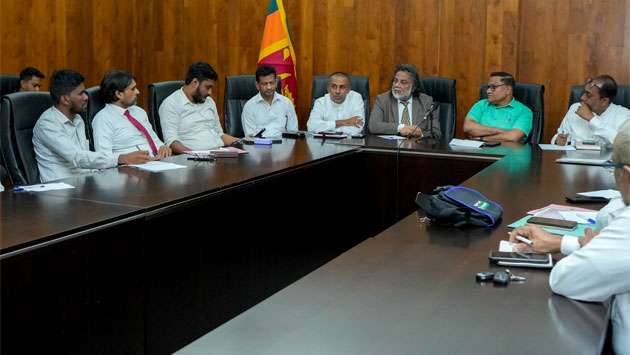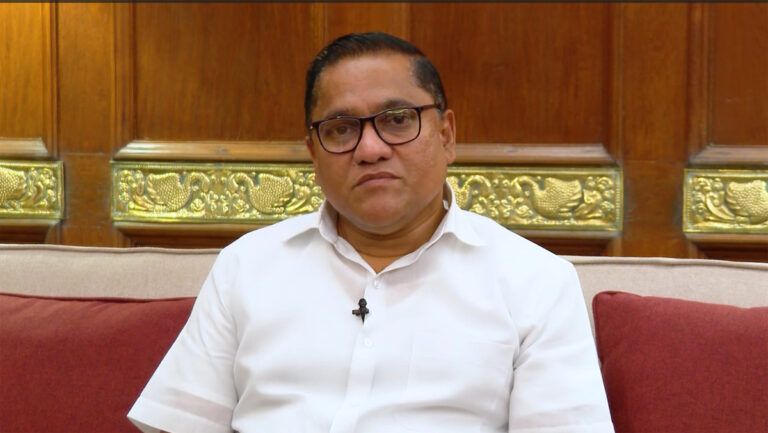October 25, Colombo (LNW): Minister of Foreign Affairs, Foreign Employment, and Tourism, Vijitha Herath, has urged that Muslim burial rites be conducted without unnecessary delay, stressing the importance of upholding pre-pandemic practices.
Representatives from various civil society groups observed that in certain regions, procedures introduced during the COVID-19 period—particularly the extended certification process—were still being applied, resulting in significant postponements of burials.
Responding to these concerns, Minister Herath clarified that a circular reinstating the standard pre-COVID procedures has already been issued, and relevant officials have been instructed to ensure its full implementation. He further advised that in any locality where outdated regulations remain in use, the circular should be presented to the authorities so that corrective measures can be promptly enforced.
The meeting, attended by around 30 representatives from 15 organisations including the All Ceylon Jamiatul Ulama, provided a platform for Muslim community leaders to raise wider social concerns.
During the same discussion, Minister Herath also reaffirmed that there are no legal restrictions preventing Muslim nurses in public hospitals from wearing attire consistent with their faith. The reassurance followed appeals from Muslim civil society groups, who noted that limitations on wearing garments covering the head and legs have deterred many Muslim women from entering or remaining in the nursing profession.
The meeting, chaired by Minister Herath, included participation from Deputy Speaker Rizvi Sali, Minister Sunil Senevi, Deputy Ministers Munir Mulaffar and Arkam Ilyas, and MP Fasmin Sheriff. Minister Herath emphasised that existing uniform policies do not conflict with religious dress codes, underscoring that cultural and spiritual observances should never impede anyone’s opportunity to serve in the healthcare sector.
Minister Calls for Prompt Muslim Burial Procedures and Affirms Religious Rights of Nurses
Showers, thundershowers continue: Fairly heavy falls above 75 mm likely to occur (Oct 25)
October 25, Colombo (LNW): Showers or thundershowers will occur at times in Western, Sabaragamuwa, Central and North-western, Northern and North Central provinces and in Galle, Matara and Trincomalee districts, the Department of Meteorology said in its daily weather forecast today (25).
Fairly heavy falls above 75 mm are likely at some places in these areas.
Showers or thundershowers will occur elsewhere of the island after 1.00 p.m.
Strong winds of about (40-50) kmph can be expected at times over Western slopes of the central hills and in Western, Northern, North-central, North-western and Southern provinces and in Trincomalee district.
The general public is kindly requested to take adequate precautions to minimise damages caused by temporary localised strong winds and lightning during thundershowers.
Marine Weather:
The low-pressure area located over the southeast Bay of Bengal to the northeast of Sri Lanka is expected to intensify further and move west-northwestward. This low-pressure area located about 850 km northeast of Batticaloa at 5.00 a.m. on October 25, 2025. This low-pressure system is likely to develop into a depression over the southeast and adjoining central Bay of Bengal during today (25). This system is expected to further intensify into a deep depression by the 26th of October and into a cyclonic storm by October 27. Naval and fishing communities, engaging activities over the shallow sea areas off the coast extending from Kankasanthurai to Batticaloa via Trincomalee and from Galle to Pottuvil via Hambantota are requested to be vigilant in this regard.
Condition of Rain:
Showers or thundershowers will occur at times in the sea areas off the coast extending from Trincomalee to Hambanthota via Kankasanthurai, Mannar, Colombo and Galle. Showers or thundershowers will occur at several places in other sea areas around the island during the afternoon or night.
Winds:
Winds will be south-westerly or westerly and speed will be (30-40) kmph. Wind speed can increase up to (50-60) kmph at times in the sea areas around the island.
State of Sea:
The sea areas around the island will be fairly rough and, rough at times.
Temporarily strong gusty winds and very rough seas can be expected during thundershowers.
George Steuart Health Honours Excellence at Achievers Night 2025
Colombo, Sri Lanka – October 2025
George Steuart Health (Pvt) Ltd., the fastest-growing pharmaceutical importer in Sri Lanka and the healthcare arm of the George Steuart Group, celebrated the outstanding achievements of its employees and distributors at Achievers Night 2025, held recently in Colombo. The event recognized exceptional performers in sales revenue and growth across four key categories, Pharma, Non-Pharma, Distribution Partners and Sales Team, reflecting the company’s commitment to excellence, resilience, and collaboration.
With a team of over 600 members, the winning teams andpartners from across Sri Lanka came together to honour the dedication and teamwork that have positioned George Steuart Health among the top four pharmaceutical firms in the country. The awards highlight the significant contributions made during a year marked by industry challenges and regulatory changes.
Commenting on the occasion, Managing Director – Eran Ranasinghe said:
“This past year tested us with unprecedented challenges. Yet, through unwavering unity, adaptability, and courage, our teams not only persevered, they thrived. We strengthened global partnerships, expanded into new product categories, and deepened our reach across hospitals and communities.
Tonight, we celebrate not just individual and team successes, but the collective spirit that defines George Steuart Health. Our ambition goes beyond market leadership; it’s about making a profound impact on healthcare in Sri Lanka. As we look to the future, we are proud to be expanding into local manufacturing, developing breakthrough products and new chemical entities that will deliver world-class care made right here at home.
Together, we are building a healthier tomorrow for Sri Lanka, and this unstoppable spirit will drive us to even greater heights.”
George Steuart Health, established in 1986 and rebranded in 2012, partners with over 70 global manufacturers and markets more than 600 pharmaceutical products and medical devices. The company covers a wide range of therapeutic areas including Oncology, Cardiology, Dermatology, Rheumatology, Gastroenterology, Ophthalmology, and Sports Medicine.
As the healthcare division of the George Steuart Group, which boasts over 190 years of business excellence, George Steuart Health continues to innovate and expand its footprint, maintaining a legacy of integrity, quality, and service.
Looking ahead, the company’s strategic entry into local pharmaceutical manufacturing marks a significant milestone, strengthening Sri Lanka’s healthcare ecosystem and ensuring greater accessibility to advanced medical solutions.
The ceremony closed on a note of optimism and determination, reaffirming George Steuart Health’s commitment to shaping the future of healthcare in Sri Lanka.
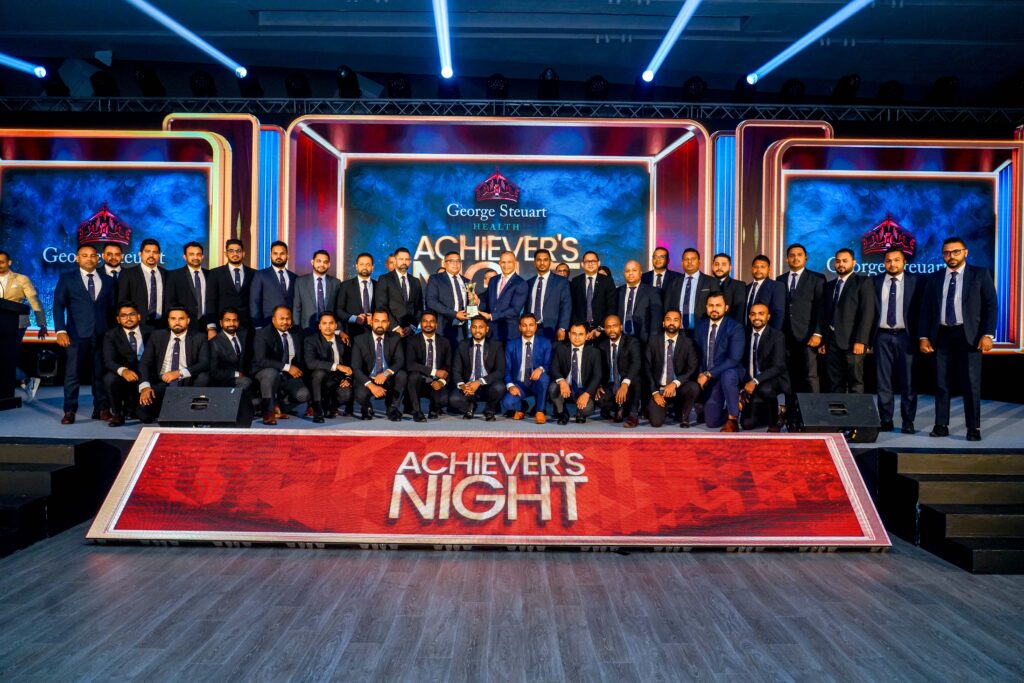
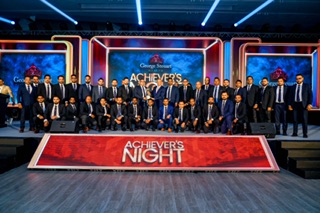

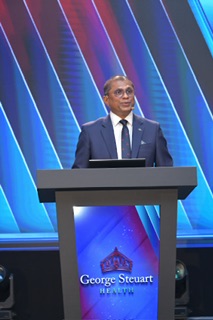

When Will the CBSL Stop Banks from Adding 10% to Credit Card Forex Transactions?
By Adolf
Sri Lankan banks are quietly profiting from a practice that has gone unchecked for far too long — adding unjustified margins of up to 10% on foreign currency transactions made through credit cards. This practice, particularly visible in the case of American Express with a staggering 10% margin, and Mastercard and Visa with margins ranging from 5% to 8%, is nothing short of a rip-off of ordinary retail customers. It is a silent tax on consumers, imposed by the banks and tolerated by a Central Bank that appears to have lost touch with the realities faced by the public.
While the Central Bank of Sri Lanka (CBSL) continues to host events, publish reports, and celebrate its so-called achievements, millions of cardholders are being penalized every time they use their credit cards for legitimate online or overseas transactions. The additional “foreign exchange conversion margin” — which banks claim covers exchange rate volatility and operational costs — is grossly excessive and far beyond international norms. In most developed markets, central banks and financial regulators strictly cap these margins at 1–2%, ensuring that consumers are treated fairly and transparently.
In Sri Lanka, however, the story is different. The banks, emboldened by regulatory inaction, have turned forex-related card transactions into a lucrative profit centre. The irony is that they would never dare to impose such steep margins on corporate clients or large exporters. Those customers are better informed, have bargaining power, and can access foreign exchange directly through market mechanisms. Retail consumers, on the other hand, are easy targets — their small, scattered transactions go unnoticed, and the extra costs are buried in complex exchange rate calculations that few can decipher.
The result is a deeply unfair two-tier system: one set of rules for powerful corporates, and another for ordinary citizens. Every time a Sri Lankan family pays for an online course, books a hotel abroad, or subscribes to an international service, they are effectively being charged 10% more than what the exchange rate justifies. This is not only anti-consumer but also economically regressive. It discourages legitimate spending, erodes trust in the banking system, and fuels resentment towards institutions that are supposed to protect the public interest.
The CBSL cannot continue to look the other way. As the regulator of the financial system, it has both the authority and the duty to stop this practice. The Central Bank’s silence amounts to tacit approval, allowing banks to report inflated profits at the expense of the very customers they are meant to serve.
If Sri Lanka aspires to build a modern, fair, and transparent financial system, it must start with basic consumer protection. The CBSL must immediately issue clear guidelines capping foreign exchange conversion margins for credit card transactions at international norms. Accountability must replace complacency. The time for half-measures is over — retail customers deserve fairness, transparency, and respect, not exploitation disguised as policy.
Over 700 Acres of Land Released in North and East – Deputy Defence Minister
Deputy Defence Minister Major General (Retd.) Aruna Jayasekara informed Parliament yesterday that over 700 acres of land in the Northern and Eastern Provinces have been released to the public so far this year (2025).
He said that between January 1 and October 10, a total of 672.24 acres of land in the Northern Province have been returned to the people. This includes 86.24 acres of privately-owned land and 586 acres previously occupied by the military.
In the Eastern Province, 34.58 acres of government land have also been released during the same period, he added.
The Deputy Minister further noted that issues surrounding land in Eechankulam, in the Vavuniya District, are currently being addressed and are expected to be resolved soon to facilitate public release.
He explained that the lands were released following the submission of relevant documentation to the National Security Council (NSC) and the Sectoral Oversight Committee on National Security.
Deputy Defence Minister Jayasekara made these remarks in response to a question raised in Parliament by Illankai Tamil Arasu Kachchi (ITAK) MP Pathmanathan Sathiyalingam.
India, Sri Lanka Urged to Strengthen Indian Ocean Protection
India’s incoming Chief Justice, Justice Surya Kant, has called for enhanced cooperation between India and Sri Lanka to protect the Indian Ocean, stressing that environmental collaboration is a matter of survival, not charity or diplomacy. His remarks came during an address at the University of Colombo on the second day of his three-day visit to Sri Lanka.
Justice Kant reflected on the historical significance of the waters separating the two nations, describing them as ancient conduits of culture, trade, and ideas. “The time has come for India and Sri Lanka to pioneer a regional model of environmental constitutionalism,” he said, urging both countries to lead by example in safeguarding the marine ecosystem.
During the visit, he also announced that a delegation of Sri Lankan Supreme Court judges is expected to visit India later this year or early 2026. The initiative, Justice Kant noted, aims to strengthen judicial dialogue and foster institutional collaboration between the two judiciaries.
Highlighting ecological interdependence, Justice Kant described the Indian Ocean as a historic bridge connecting the peoples of India and Sri Lanka through shared ecosystems, faith, and culture. Yet, he warned that beneath the calm waters of the Palk Strait, signs of ecological stress are mounting: oil spills drifting across shores, coral bleaching due to rising temperatures, and fishing communities whose livelihoods are increasingly precarious due to policy decisions made in both capitals.
The Palk Bay and Gulf of Mannar, once biodiversity-rich zones, now face severe pressure from overfishing, destructive trawling, and unregulated coastal activity. Recurring confrontations between Indian trawlers and Sri Lankan fishers, he explained, exemplify “a deeper ecological tragedy—competition for an exhausted resource base.”
Justice Kant also highlighted the impacts of climate change, including saltwater intrusion, microplastic accumulation, and uncoordinated disaster responses, urging both nations to share data, monitor ecosystems jointly, and implement coordinated policies to mitigate environmental degradation.
He emphasised the judiciary’s role as a “moral and constitutional guardian” of ecological balance, noting that both India and Sri Lanka have developed strong environmental jurisprudence. Justice Kant’s visit underscores the growing recognition that sustainable management of marine resources requires not just bilateral cooperation, but also a robust legal framework backed by institutional coordination.
By fostering judicial dialogue, promoting shared monitoring mechanisms, and addressing systemic environmental challenges, India and Sri Lanka could create a regional model for sustainable ocean governance, potentially inspiring similar frameworks across the Indian Ocean rim.
Government Assures Data Safety after Lanka Cloud Outage
Deputy Minister of Digital Economy Eranga Weeraratne yesterday assured Parliament that no government or citizen data was compromised following the unexpected collapse of the Lanka Government Cloud (LGC) on October 14, 2025.
“All sensitive citizen and institutional data remain fully intact,” the Minister emphasized, confirming that the National Cyber Security Operations Centre (NCSOC) had monitored the incident in real time and detected no unauthorized access or breach attempts.
The assurance came amid questioning from MP Ravi Karunanayake of the New Democratic Front, who sought clarity on the cause of the failure, accountability, and the government’s readiness to avoid similar disruptions in future.
Minister Weeraratne explained that the failure was not the result of a cyberattack but a technical fault caused by a storage disk reaching 100% utilisation, triggering an automatic shutdown protocol. This mechanism, he said, is a built-in safety feature designed to protect data integrity and prevent corruption.
“This was not a system-wide failure but a controlled shutdown,” Weeraratne clarified. “Services were restored by Saturday night, after comprehensive validation to ensure all data remained secure.”
Karunanayake pressed for transparency, urging the government to table a cybersecurity audit report and outline measures to rebuild confidence in the country’s digital infrastructure.
In response, Weeraratne unveiled a broad national cybersecurity strategy aimed at strengthening resilience and governance. Key measures include:
Full implementation of the national cybersecurity policy and mandatory penetration testing across government institutions.Identification of Critical Information Infrastructure (CII) in key sectors such as finance, health, and energy.
Establishment of a Cybersecurity Regulatory Authority (CSRA) with statutory enforcement powers.Ratification of the UN Cybercrime Convention to boost international cooperation.
Enhanced coordination with Sri Lanka CERT, TRCSL, CBSL, and licensed banks to combat phishing and digital fraud.
Karunanayake also proposed creating a National Cybersecurity Command Authority to centralize monitoring and emergency response. The Minister confirmed that cabinet approval processes are already underway to establish such a body under new legislation.
Sri Lanka Urged to Fast-Track Market Reforms to Boost Investment
Sri Lanka must urgently accelerate reforms in its land, labour, and capital markets the three critical factor markets that drive investment while maintaining fiscal discipline to curb domestic debt growth, University of Peradeniya Economics Professor Wasantha Athukorala said this week.
Commenting through the Department of Government Communication, Prof. Athukorala noted that improved fiscal management has helped stabilise the country’s borrowing trajectory after years of excessive debt expansion. “The increase in total public debt since January 2025 has been minimal, showing signs of stabilisation,” he said.
As of June 2025, Sri Lanka’s total public debt stood at Rs. 29,634 billion, comprising Rs. 18,806 billion in domestic debt and Rs. 10,800 billion in external debt. However, he cautioned that comparing domestic and external debt in the same currency terms often leads to misleading conclusions. “Either both must be expressed in rupees or both in foreign currency. Mixing the two distorts the real picture due to exchange rate effects,” he explained.
Prof. Athukorala pointed out that domestic debt growth, which had previously risen at alarming rates, has now slowed significantly. Between 2019 and 2024, domestic borrowing surged by more than Rs. 100 billion per month on average, peaking at Rs. 327 billion per month in 2022. “In contrast, during the first six months of 2025, monthly growth has moderated to about Rs. 49–50 billion a welcome trend,” he added.
Domestic debt expanded by nearly Rs. 4 trillion in 2022 and Rs. 2 trillion in 2023, before slowing to Rs. 1.25 trillion in 2024. By mid-2025, it had increased by only Rs. 296 billion. “This must come down further,” he urged, warning that unchecked domestic borrowing could increase the future tax burden and destabilise the economy.
Since Sri Lanka’s 2022 debt default, access to international capital markets remains closed, forcing the government to rely on multilateral and limited bilateral lending. Prof. Athukorala said maintaining restraint on domestic debt and disciplined external borrowing could pave the way for greater macroeconomic stability.
Turning to investment, he observed that foreign direct investment (FDI) inflows have consistently fallen short, barely reaching US$ 1 billion annually. He attributed this weakness to structural inefficiencies in the land, labour, and capital markets, and Sri Lanka’s poor performance in global ease-of-doing-business rankings.
Nonetheless, recent trends show promise. Between January and August 2025, the Board of Investment (BOI) approved 81 projects worth US$ 861 million, expected to create over 20,000 jobs. Of these, 57% were in manufacturing, 14% in construction, 9% in garment manufacturing, and 4% in the knowledge economy. India accounted for 55% of FDI approvals, followed by Singapore (27%), China (10%), and the United States.
“If this momentum continues, Sri Lanka’s FDI inflows could exceed US$ 1 billion in 2025,” Prof. Athukorala said. However, he emphasised that this remains inadequate for sustainable growth. “Over the next five years, the country should target annual FDI of around US$ 5 billion, particularly in emerging technologies and IT. The Government must act swiftly to remove barriers and attract quality investments,” he stressed.
Sri Lanka’s Exports Rise 7% in First Nine Months of 2025, Reaching Nearly USD 13 Billion
Sri Lanka’s export sector has maintained strong resilience and steady growth during the first nine months of 2025, with total earnings reaching US$ 12,986.52 million, marking a 7% increase compared to the same period in 2024, according to the Export Development Board (EDB).
In September 2025 alone, total exports — combining merchandise and services — amounted to US$ 1,469.75 million, reflecting a 12.33% year-on-year increase, underscoring the effectiveness of strategies to enhance global market access and competitiveness.
EDB Chairman and CEO Mangala Wijesinghe stated that this performance reflects Sri Lanka’s deepening integration into global trade and the success of ongoing efforts to diversify markets and strengthen export competitiveness.
“Exceeding US$ 12.9 billion in cumulative export earnings by September 2025 demonstrates the strength and determination of our exporters. With over 72% of the annual target already achieved by the third quarter, we are confident of meeting our 2025 export goal,” he said.
Key Performance Highlights (January–September 2025)
- Total exports: US$ 12,986.52 million (+6.92%)
- Merchandise exports: US$ 10,240.52 million (+7.59%)
- Services exports: US$ 2,746.03 million (+4.49%)
September 2025 Breakdown
Merchandise Exports
- Total: US$ 1,163.66 million (+15.02%)
Top Performing Sectors:
- Apparel & Textiles: US$ 425.07 Mn (+1.53%)
- Tea: US$ 137.0 Mn (+17.06%) — driven by higher exports of tea packets, bulk tea, and instant tea.
- Tea exports to Iraq (+28.86%), Turkey (+122.6%), and Libya (+12.5%) showed notable growth.
- Coconut-based Products: +72.03% overall
- Coconut kernel products +100.34%
- Coconut fibre products +44.43%
- Coconut shell products +33.7%
- Food & Beverages: +50.11% (Processed food +71.97%)
- Seafood: +53.07% (Fresh fish +108.16%, Frozen fish +53.9%)
- Diamonds, Gems & Jewellery: +76.95% (US$ 43.53 Mn)
- Electrical & Electronic Components: +29.5% (US$ 36.39 Mn)
- ICT/BPM services: +27.05% (US$ 157.76 Mn)
Sectors with Decline:
- Rubber products: -6.55% (US$ 74.29 Mn)
- Spices & Essential Oils: -10.18%, mainly due to lower pepper exports to India (-60.2%)
- Logistics & Transport Services: -14.95%
Cumulative Growth by Sector (Jan–Sep 2025)
- Apparel & Textiles: US$ 4,011.66 Mn (+6.22%)
- Exports to US (+2.03%), UK (+2.47%), EU (+14.08%)
- Tea: US$ 1,163.05 Mn (+9.8%)
- Coconut Products: US$ 909.09 Mn (+41.83%)
- Spices & Essential Oils: US$ 329.84 Mn (+2.41%) — driven by Cinnamon (+21.83%) and Cloves (+172.82%)
- Food & Beverages: US$ 435.31 Mn (+24.75%)
- Seafood: US$ 184.56 Mn (+2.89%)
- Electrical & Electronic Components: US$ 315.96 Mn (+1.77%)
- ICT/BPM Services: US$ 1,201.2 Mn (+9.27%)
- Logistics & Transport: US$ 1,403.0 Mn (+6.67%)
Sectors with Decline (Jan–Sep 2025):
- Rubber & Finished Products: US$ 713.62 Mn (-5.97%)
- Ornamental Fish: US$ 17.97 Mn (-3.96%)
Sectoral Insights
Sri Lanka’s tea and coconut industries continue to thrive, benefiting from increased demand in the Middle East and Asia, while ICT and BPM services have solidified their role as key contributors to export diversification.
The EDB noted that the agri-industrial, seafood, and electronic components sectors also displayed strong potential for value-added growth.
Overall, the 2025 performance indicates that Sri Lanka’s export strategy — focused on innovation, market diversification, and knowledge-based growth — is positioning the country on a more sustainable export-led development path.
Foreign Minister Vijitha Herath Meets Muslim Civil Society Leaders to Address Community Concerns
Minister of Foreign Affairs, Foreign Employment and Tourism Vijitha Herath met with a group of Muslim civil society leaders today to discuss issues faced by the Muslim community in Sri Lanka.
During the meeting, held at the Ministry of Foreign Affairs, discussions focused on concerns regarding the cultural attire of Muslim nurses employed in government hospitals and delays in burial procedures for deceased persons due to outdated COVID-19–era guidelines.
Minister Herath clarified that no legal restrictions exist preventing Muslim nurses from wearing attire that reflects their religious and cultural identity, provided it remains consistent with existing regulations governing official duties.
He further noted that a circular reinstating pre-pandemic burial procedures has already been issued, ensuring that burial practices can now be conducted under the same guidelines that existed prior to the COVID-19 period.
The meeting was attended by Deputy Speaker Rizvi Sally, Minister Sunil Senewiratne, State Ministers Muneer Mulaffar and Arkam Illyas, and MP Fasmim Sherif.
Representatives from 15 Muslim civil society organizations, including religious leaders and members of the All Ceylon Jamiyyathul Ulama (ACJU), also took part in the discussions, engaging in a constructive dialogue on strengthening mutual understanding and addressing longstanding community concerns.

